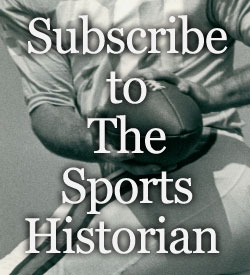Scotland held the distinction of the golf capital of the world in the nineteenth century. In the 1850s, St. Andrews clubmaker Allan Robertson held the honor as the country’s (and the world’s, for that matter) best golfer, according to www.theopen.com. After his death in 1859, a debate ensued as to Robertson’s successor. Two influential members of the Prestwick Golf Club, the Earl of Eglinton and Colonel James Fairlie, decided that a tournament should be held at Prestwick to determine the greatest golfer in the world. Clubs and golfing societies in Blackheath, Perth, Edinburgh, Musselburgh, and St. Andrews received letters asking them to send their best golfers to play a three-round, one day tournament on the 12-hole Prestwick course on October 17, 1860. The winner would receive the Challenge Belt, a red Moroccan leather belt that featured silver panels of golfing scenes. However, the winner would not receive any money. Eight golfers participated in the first Open Championship. Willie Park, Sr. from Musselburgh beat Tom Morris, Sr. from Prestwick by two strokes. The Open Championship was off and running.
The tournament remained at Prestwick from 1860-1870, with the winners receiving the Challenge Belt to hold until the tournament the following year. Prize money became part of the Open beginning in 1863. Open officials retired the Belt as the winner’s prize after Tom Morris’ son, Tom Morris, Jr., won it three years in a row, whereby a rule stipulated that Tom Jr. could keep the Belt as his own. Without a trophy of some type, the tournament skipped 1871. That same year Prestwick officials agreed to join the Royal and Ancient of St. Andrews and the Honourable Company of Edinburgh Golfers in Musselburgh in a three-site rotation to host the Open. Prestwick held the Open in 1872 and the winner, Tom Morris, Jr., received a gold medal. The first Claret Jug was presented to the winner of the 1873 Open, Tom Kidd. However, Tom Morris, Jr. had his name engraved on the trophy (along with Kidd’s) as its first winner in 1872. The Claret Jug has been awarded to the Open winner ever since.
During the 1890s, the Open became a four day, 72-hole event; the Royal St. George’s Golf Club in England hosted the tournament for the first time outside of Scotland; and because of the large number of participants, a cut after two rounds became a standard. In 1920, the Royal and Ancient Golf Club assumed the responsibility for the staging and management of the Open. The Open became an official PGA Tour event in 1995, meaning that any prize money won by a participant would be included in the official PGA money list (important for maintaining PGA Tour status and gaining exemptions into PGA-sponsored tournaments).
The Open rotates among ten links courses (generally treeless courses built along a coast that incorporate the natural uneven terrain of their locations). These are the Old Course at St. Andrews; Carnoustie Golf Links in Carnoustie, Scotland; Muirfield in Gullane, Scotland; the Ailsa Course at the Westin Turnberry Resort near Girvan, Scotland; Royal Troon Golf Club in Troon, Scotland; Royal St. George’s Golf Club in Sandwich, England; Royal Birkdale Golf Club in Southport, England; Royal Lytham and St. Anne’s Golf Club in Lytham St. Annes, England; Royal Liverpool Golf Club in Hoylake, England and Royal Portrush Golf Club in Portrush, Northern Ireland. Besides the unique terrain, these courses are all affected by the weather, which can change dramatically in a matter of hours. More so than the other majors, the weather can destroy a player’s round.
Professionals have dominated the Opens, as only six amateurs have ever won one. The last amateur to win the Open was Bobby Jones in 1930, the year he won the Grand Slam (U.S. and British Amateurs and the U.S. and British Opens). England’s Harry Vardon holds the record with six Open titles (1896, 1898, 1899, 1903, 1911 and 1914). Those who won five include, England’s J. H. Taylor (1894, 1895, 1900, 1909 and 1913), James Braid from England (1901, 1905, 1906, 1908 and 1910), Australian Peter W. Thomson (1954, 1955, 1956, 1958 and 1965), and American Tom Watson (1975, 1977, 1980, 1982, and 1983). Scotland’s Tom Morris, Sr. won four (1861, 1862, 1864 and 1867) as did his son, Tom Morris, Jr. (1868, 1869, 1870 and 1872). Other notable winners are Jack Nicklaus (1966, 1970 and 1978) and Tiger Woods (2000, 2005 and 2006). South Africa’s Gary Player holds the Open record with 46 appearances, including titles in 1968 and 1974.
The current Open field allows for 156 golfers chosen from various sources, including the top 50 in the Official World Golf Ranking; the top 30 in last season’s European Tour Race to Dubai and PGA Tour FedEx Cup; all previous Open Champions 60 years old or younger; winners of the other three majors within the last five years; the top 10 from the previous year’s Open; and the winners of the British Amateur and United States Amateur, as long as the winners are still amateurs. The Open winner receives about $1.8 million, and the tournament, since 1979, has been played during the week that contains the third Friday of July.
Inside Great Britain, the tournament is referred to as the Open or The Open Championship. Everywhere else, it is referred to as the British Open. Whatever the name, old Allan Robertson (hopefully, somewhere above us) must be proud of the tournament that was initiated to find the successor to his title as the greatest golfer in the world.


















